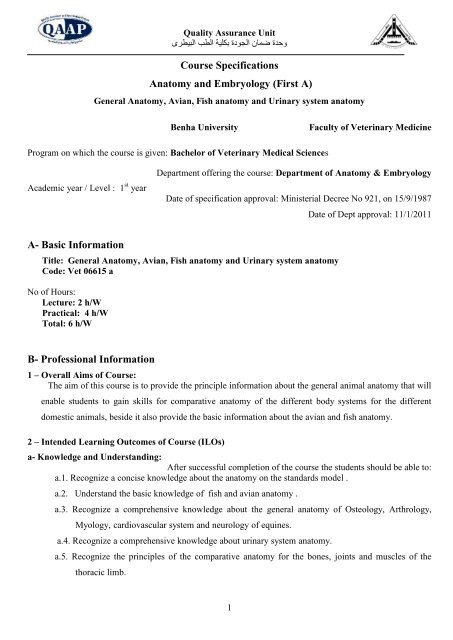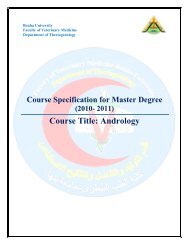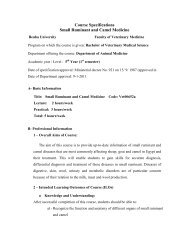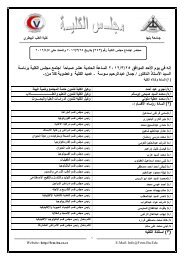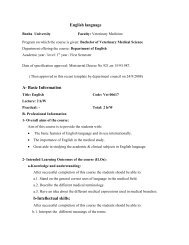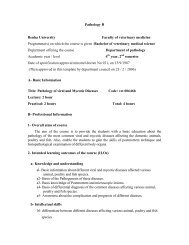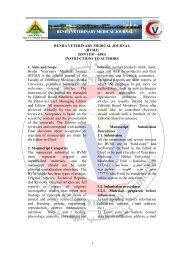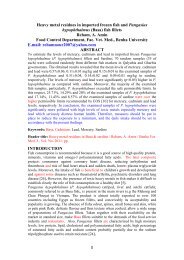Course Specifications Anatomy and Embryology (First A) A- Basic ...
Course Specifications Anatomy and Embryology (First A) A- Basic ...
Course Specifications Anatomy and Embryology (First A) A- Basic ...
Create successful ePaper yourself
Turn your PDF publications into a flip-book with our unique Google optimized e-Paper software.
Quality Assurance Unit<br />
وحدة ضمان الجودة بكليت الطب البيطرى<br />
<strong>Course</strong> <strong>Specifications</strong><br />
<strong>Anatomy</strong> <strong>and</strong> <strong>Embryology</strong> (<strong>First</strong> A)<br />
General <strong>Anatomy</strong>, Avian, Fish anatomy <strong>and</strong> Urinary system anatomy<br />
Benha University<br />
Faculty of Veterinary Medicine<br />
Program on which the course is given: Bachelor of Veterinary Medical Sciences<br />
Academic year / Level : 1 st year<br />
Department offering the course: Department of <strong>Anatomy</strong> & <strong>Embryology</strong><br />
Date of specification approval: Ministerial Decree No 921, on 15/9/1987<br />
Date of Dept approval: 11/1/2011<br />
A- <strong>Basic</strong> Information<br />
Title: General <strong>Anatomy</strong>, Avian, Fish anatomy <strong>and</strong> Urinary system anatomy<br />
Code: Vet 06615 a<br />
No of Hours:<br />
Lecture: 2 h/W<br />
Practical: 4 h/W<br />
Total: 6 h/W<br />
B- Professional Information<br />
1 – Overall Aims of <strong>Course</strong>:<br />
The aim of this course is to provide the principle information about the general animal anatomy that will<br />
enable students to gain skills for comparative anatomy of the different body systems for the different<br />
domestic animals, beside it also provide the basic information about the avian <strong>and</strong> fish anatomy.<br />
2 – Intended Learning Outcomes of <strong>Course</strong> (ILOs)<br />
a- Knowledge <strong>and</strong> Underst<strong>and</strong>ing:<br />
After successful completion of the course the students should be able to:<br />
a.1. Recognize a concise knowledge about the anatomy on the st<strong>and</strong>ards model .<br />
a.2. Underst<strong>and</strong> the basic knowledge of fish <strong>and</strong> avian anatomy .<br />
a.3. Recognize a comprehensive knowledge about the general anatomy of Osteology, Arthrology,<br />
Myology, cardiovascular system <strong>and</strong> neurology of equines.<br />
a.4. Recognize a comprehensive knowledge about urinary system anatomy.<br />
a.5. Recognize the principles of the comparative anatomy for the bones, joints <strong>and</strong> muscles of the<br />
thoracic limb.<br />
1
- Intellectual Skills<br />
Quality Assurance Unit<br />
وحدة ضمان الجودة بكليت الطب البيطرى<br />
After successful completion of the course the students should be able to:<br />
b.1. Apply a Comprehensive knowledge about the general Osteology, Arthrology, Myology <strong>and</strong><br />
neurology of equines <strong>and</strong> the comparative anatomy of the other different domestic farm animal<br />
species.<br />
b.2. Use the best steps for the avian <strong>and</strong> fish dissection.<br />
b.3. Differentiate the bones of the thoracic limb for the all animal species in addition to the joints of<br />
forelimb in equines.<br />
b.4. Distinguish the site of origin of the different peripheral nerves.<br />
b.5. Inspect the origin <strong>and</strong> insertion of different skeletal muscles .<br />
b.6. Compare between the different organs of urinary system in different animals.<br />
c- Professional <strong>and</strong> Practical Skills<br />
After successful completion of the course the students should be able to:<br />
c.1. Measure the professional capability to dissect the thoracic limb.<br />
c.2. Measure the professional capability to identify the shape <strong>and</strong> position of the thoracic limb bones.<br />
c.3. Evaluate the skills to compare between bones <strong>and</strong> joints of the thoracic limb of different domestic<br />
animals .<br />
c.4. Evaluate the skills for determination of the different organs of fish <strong>and</strong> poultry.<br />
d- General <strong>and</strong> Transferable Skills<br />
After successful completion of the course the students should be able to:<br />
d.1. Use computers (word, spreadsheet, presentation, database).<br />
d.2. Use internet <strong>and</strong> conduct a search in digital library.<br />
d.3. Make oral presentations.<br />
d.4. Retrieve information from different sources independently.<br />
d.5. Solve any scientific problem.<br />
d.6. Know group dynamics to reach objectives<br />
d.7. Recognizing <strong>and</strong> identifying views of others<br />
d.8. Schedule tasks in order of importance<br />
d.9. Facilitate learning to all team<br />
3- Contents:<br />
Topic No. of hours Lecture Practical<br />
General Osteology 2 2 -<br />
General Arthrology (syndesmology) 2 2 -<br />
2
Quality Assurance Unit<br />
وحدة ضمان الجودة بكليت الطب البيطرى<br />
General Myology 2 2 -<br />
General Nervous System 2 2 -<br />
General Cardiovascular System 2 2 -<br />
Avian <strong>Anatomy</strong> 12 10 2<br />
Fish <strong>Anatomy</strong> 8 6 2<br />
Urinary System 4 4 -<br />
Bones of the thoracic limb 24 - 24<br />
Dissection of the thoracic limb of horse<br />
Special Arthrology of forelimb of horse<br />
30<br />
2<br />
- 30<br />
Total 90 30 60<br />
2<br />
-ILOs matrix<br />
Content<br />
Knowledge<br />
<strong>and</strong><br />
underst<strong>and</strong>ing<br />
ILOs<br />
Intellectual Professional<br />
<strong>and</strong> practical<br />
General <strong>and</strong><br />
transferable<br />
General Osteology<br />
b1 c2 d6-d7-d8-d9<br />
a3<br />
General Arthrology (syndesmology)<br />
b1 c3 d6-d7-d8-d9<br />
a3<br />
General Myology<br />
b1 c1 d6-d7-d8-d9<br />
a3<br />
General Nervous System<br />
b1<br />
d6-d7-d8-d9<br />
a3<br />
General Cardiovascular System<br />
b1<br />
d6-d7-d8-d9<br />
a3<br />
Avian <strong>Anatomy</strong><br />
b2 c4 d6-d7-d8-d9<br />
a2<br />
Fish <strong>Anatomy</strong> a2 b2 c4 d6-d7-d8-d9<br />
Urinary System a4 b6 d6-d7-d8-d9<br />
Bones of the thoracic limb a3 -a5 b3 c2 -c3 d6-d7-d8-d9<br />
Dissection of the thoracic limb of horse a5 b4 -b5 c1 d6-d7-d8-d9<br />
Special Arthrology of forelimb of horse a3 b3 c3 d6-d7-d8-d9<br />
5- Assessment-ILOS matrix<br />
Assessment<br />
Knowledge<br />
<strong>and</strong><br />
underst<strong>and</strong>ing<br />
ILOs<br />
Intellectual Professional<br />
<strong>and</strong> practical<br />
General <strong>and</strong><br />
transferable<br />
Practical examination a3-a5 b3-b4-b5 c1-c2-c3 d6-d7-d8-d9<br />
3
Quality Assurance Unit<br />
وحدة ضمان الجودة بكليت الطب البيطرى<br />
Final- term examination<br />
Oral examination<br />
Mid term<br />
a2-a3-a4-a5<br />
a2-a3-a4-a5<br />
a3-a4-a5<br />
b1-b2-b3-<br />
b4-b5-b6<br />
b1-b2-b3-<br />
b4-b5-b6<br />
b1-b3-b4-<br />
b5-b6<br />
c1-c2-c3-c4<br />
c1-c2-c3-c4<br />
c1-c2-c3<br />
d6-d7-d8-d9<br />
d6-d7-d8-d9<br />
d6-d7-d8-d9<br />
6– Teaching <strong>and</strong> Learning Methods<br />
Lectures <strong>and</strong> lab sessions in which one or more of the following facilities are used:<br />
6.1. Freshly died horses <strong>and</strong> donkeys.<br />
6.2. Educational models <strong>and</strong> phantoms.<br />
6.3. CD’s, Power Point slides <strong>and</strong> video tapes in lecturing.<br />
6.4. Prepared bones of died animals.<br />
6.5. Demonstrating formalin preserved carcasses.<br />
6.6. Freshly died fishes <strong>and</strong> chicken.<br />
7- Student Assessment Methods<br />
7.1. Practical examination to assess the professional <strong>and</strong> practical skills.<br />
7.2. Written examination to assess knowledge, underst<strong>and</strong>ing <strong>and</strong> intellectual skills<br />
7.3. Oral examination to assess knowledge, transferable <strong>and</strong> intellectual skills.<br />
Assessment Schedule<br />
Assessment 1: Midterm exam at week 7<br />
Assessment 2: Practical exam at week 13<br />
Assessment 3: Final- term at week 15<br />
Assessment4: Oral exam at week 15<br />
Weighting of Assessments<br />
Practical examination 30 %<br />
Final- term examination 50 %<br />
Oral examination 10 %<br />
Mid term 10 %<br />
Total 100 %<br />
8- List of References<br />
4
8.1. <strong>Course</strong> Notes.<br />
General anatomy.<br />
Avian anatomy.<br />
Fish anatomy.<br />
<strong>Anatomy</strong> of urinary system.<br />
<strong>Anatomy</strong> of thoracic limb.<br />
8.2. Recommended books:<br />
<br />
<br />
Quality Assurance Unit<br />
وحدة ضمان الجودة بكليت الطب البيطرى<br />
Getty, R (1975). Sisson <strong>and</strong> Grossman's The <strong>Anatomy</strong> of the Domestic Animals<br />
volume 1& 2. 5th edition, W B Saunders.<br />
Nickel, R., Schummer, A., Seiferle, E. / Parey, P. (1985). The <strong>Anatomy</strong> of the<br />
Domestic Animals.<br />
<br />
<br />
Atlas of veterinary anatomy<br />
Nickel, R., Schummer, A., Seiferle, E. / Parey, P. (1985). The <strong>Anatomy</strong> of the<br />
Domestic Birds.<br />
8.3. Periodicals <strong>and</strong> Web sites:<br />
Periodicals:<br />
Acta Anatomica<br />
Equine Veterinary journal.<br />
Journal of Animal Science.<br />
Research on Veterinary Science.<br />
American Journal of Veterinary <strong>Anatomy</strong>.<br />
American Journal of Veterinary Research.<br />
Veterinary Record.<br />
Web sites: http:// Pubmed.com<br />
9- Facilities Required for Teaching <strong>and</strong> Learning<br />
<br />
<br />
<br />
A laboratory for dissection <strong>and</strong> demonstration the muscles, bones <strong>and</strong> nerves of carcasses.<br />
Scalpels, knifes <strong>and</strong> saws.<br />
Holders <strong>and</strong> tanks for preservation of organs <strong>and</strong> muscles<br />
5
Quality Assurance Unit<br />
وحدة ضمان الجودة بكليت الطب البيطرى<br />
<br />
<br />
<br />
Phantoms <strong>and</strong> models for different organs <strong>and</strong> bones.<br />
Carcasses, Chicken, fishes <strong>and</strong> animals for dissection <strong>and</strong> demonstration.<br />
Fishes <strong>and</strong> birds as model for anatomy.<br />
<strong>Course</strong> Coordinator:<br />
Prof. Dr. Hatem Bahgaat Houssainy<br />
Head of Department:<br />
Prof. Dr. Hatem Bahgaat Houssainy<br />
Date: 11 / 1 / 2011<br />
6


